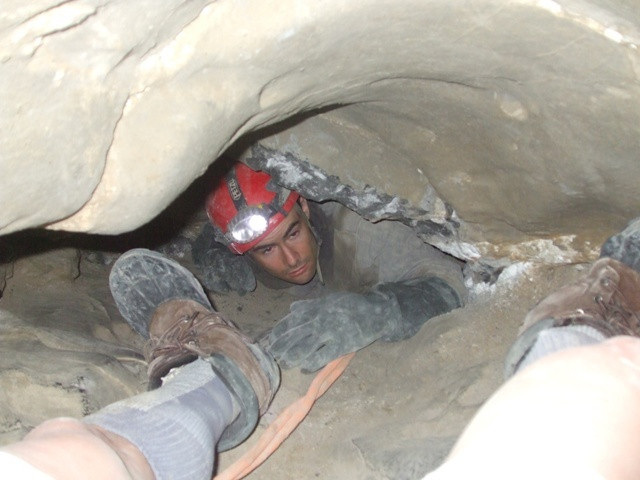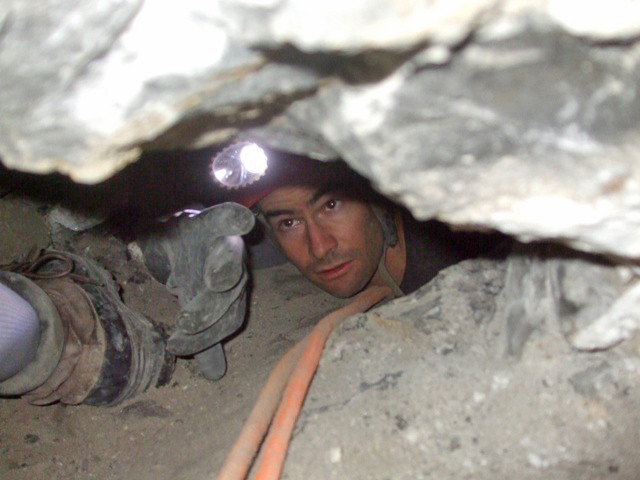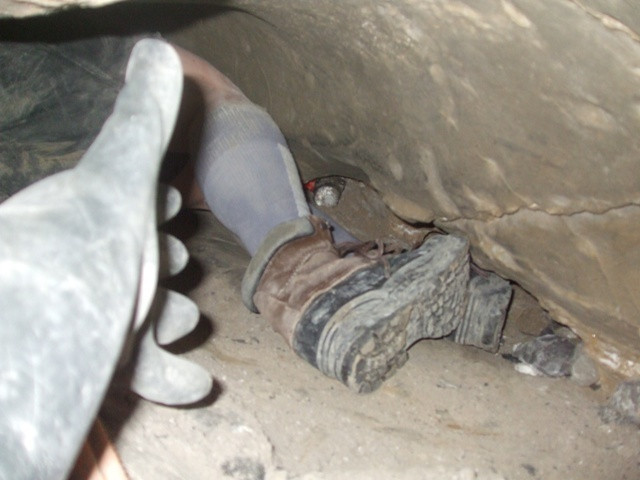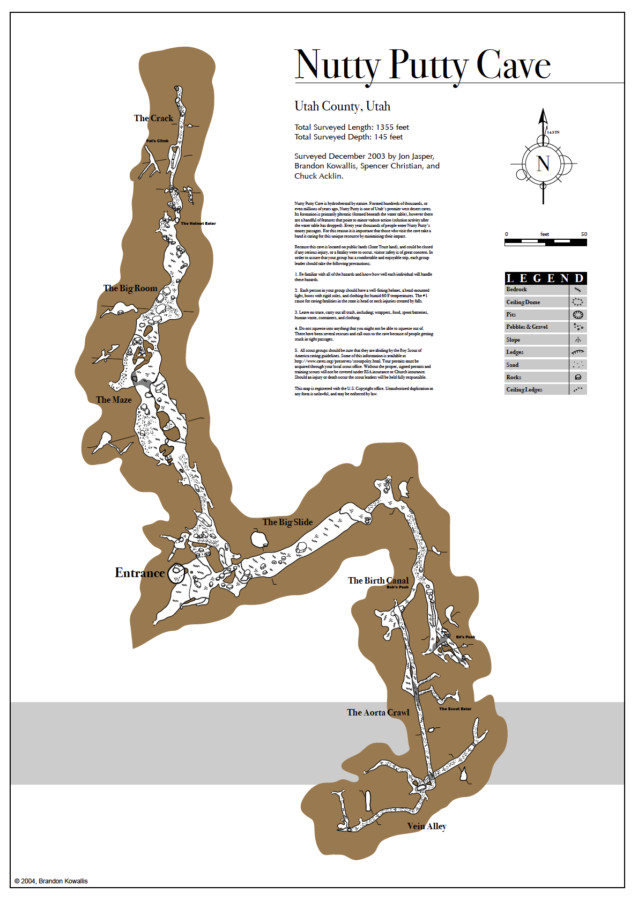In the annals of caving and rescue operations, the Nutty Putty Cave incident stands as a stark reminder of the unforgiving nature of subterranean exploration and the agonizing decisions that rescuers sometimes face. In 2009, just before Thanksgiving, I received a call to assist in the Nutty Putty Cave rescue of John Edward Jones. Unbeknownst to me at the time, I would become the last person to see John alive, arriving as he was slipping into unconsciousness. The ensuing years have brought a steady stream of inquiries about this tragic event, recently amplified by viral videos circulating online. This article serves as my attempt to provide a factual account and address the questions I am uniquely positioned to answer about the Nutty Putty Cave John Jones rescue.
The day after the heart-wrenching failure of the rescue effort, I documented my experiences while the events were still vivid in my mind. It’s crucial to understand that this is a single perspective, limited to the latter stages of the rescue operation. For a more comprehensive understanding, I highly recommend reading Lindsay Whitehurst’s detailed two-part article in the Salt Lake Tribune, which offers a broader view of the Nutty Putty cave John Jones incident.
WARNING: The following report contains descriptions of John Jones’s condition, his passing, and post-mortem details that some readers may find disturbing. In deference to John and his family, I have aimed to be as general as possible while still conveying the immense challenges we confronted during the Nutty Putty cave John Jones rescue.
Nutty Putty Rescue Report
Written for SAR on November 25, 2009
My involvement began with a call around 9:00 or 10:00 AM from Spencer Christian and Rodney Mulder. They informed me of an ongoing rescue at Nutty Putty Cave. They inquired about my availability to assist, but after assessing the situation over the phone, it seemed there were already sufficient personnel on site to manage the rescue. I communicated to Spencer and Rodney that I would be available if the operation became prolonged and fatigue set in, requiring additional support.
Approximately five hours later, Spencer contacted me again, requesting my presence. He explained that the rescue team was tiring and that smaller cavers were urgently needed. I left work around 4:00 PM, quickly stopped home to gather my caving equipment, and then drove to Nutty Putty Cave. I arrived at the scene around 6:00 PM and was assigned to the next group heading into the cave at approximately 6:30 PM.
Upon reaching the main passage at the entrance of the Birth Canal, I observed rescuers working on a 4-to-1 haul system that had been set up. I assisted with this system for about five minutes. However, it became apparent that the system was not effectively moving John (1), and the team working directly with him needed respite. Consequently, the cavers who had been attending to John began to exit the passage.
During their exit, I spoke with Andy Armstrong. I inquired about John’s condition, and Andy’s report was concerning. He indicated that John was rapidly deteriorating, drifting in and out of consciousness, and had begun experiencing hallucinations, speaking of angels and demons.
Once the previous team had exited, we decided on a course of action. I would proceed into the passage first to evaluate the situation firsthand and explore potential extraction strategies. Debbie would then follow, as she had already established rapport with John and it was believed he might find comfort in her presence.
I ventured into the narrow passage. Just before reaching John’s location, there is an exceptionally tight crawl, roughly 18 inches wide and 8 to 10 inches tall, with a sharp 90 to 120-degree turn that must be navigated feet first. Maneuvering through this restriction demands extreme care, and it’s impossible to see where your feet are placed until you are through. As I carefully wormed my way in, my feet encountered something soft – John’s feet. I felt movement, immediately lifted my feet, and shifted horizontally into the fissure.
John’s feet were approximately 6 feet beyond the constriction. I managed to position myself beside him, descending into the 4-foot-wide fissure. After securing myself by wedging my body into a narrower section of the crack, I began speaking to John, introducing myself and asking about his well-being. There was no response. I shifted slightly and tapped his leg. I could hear his breathing – deep, gurgling breaths, as if his lungs were filling with fluid. Then, his feet shifted in what seemed like a frantic attempt to free his legs from the entrapment. This kicking motion ceased abruptly, and he appeared to lapse back into unconsciousness (2). I continued to tap his legs and hip, trying to elicit a response, but there was none.
From that vantage point, I spent several minutes studying the passage, John’s positioning, and the existing rigging to assess extraction possibilities. The outlook was grim. I questioned whether moving him further was even feasible. We could persist with the haul system, but it appeared he could only be lifted another foot or two in his current position due to the webbing anchored around his knees. Any further lift would cause his feet to hit the ceiling. Once his feet reached the ceiling, there was no way to rotate him to a horizontal position; he would have to do that himself, but he was now unconscious. Even if we could achieve a horizontal position, he would still need to navigate the most constricted parts of the passage where he was trapped. If he were conscious and at full strength, there might have been a sliver of hope. But even then, it seemed incredibly difficult. Even for me, weighing only 125 pounds, exiting the passage was a struggle. At the bend in the restriction, I had to contort my body in unusual ways to slip through. Extracting a 210-pound unconscious person seemed virtually impossible. The alternative I considered was using a jackhammer to widen the crack around him, removing some rock protrusions and expanding the tightest point, allowing us to pull him straight out. This would undoubtedly result in severe lacerations and likely broken bones, but if all else failed, it seemed like the most viable option.
Between my exit and Debbie taking my place, there was a request to bring a radio to John so his family could speak to him. I believe it was his father, mother, and wife who spoke, expressing their love, prayers, and his father’s blessing. His wife conveyed a sense of peace, assuring him that everything would be alright. She spoke to him for about 5 to 10 minutes before I indicated we needed to resume efforts to extract him.
At that point, I crawled out to allow Debbie to squeeze past and assess the situation herself. However, upon reaching the tight hole, both of her legs cramped, preventing her from proceeding further. It was then that I decided to attempt using the jackhammer. We waited for it to arrive, and I carried it down to John’s location. The tool was far heavier than I anticipated, and holding it aloft while wedged in the crack was physically exhausting. Even then, achieving a favorable angle on the rock was challenging due to the confined space and my limited mobility. I managed only three attempts at a small lip of rock just below John’s foot, but the angle caused the hammer to repeatedly sink into the sand beside the rock lip. I tried repositioning, but in every other position, I struggled to maneuver the jackhammer due to its length. I only had about 2.5 feet of space between me and the rock needing drilling, while the jackhammer was approximately 3 to 4 feet long. Moreover, maintaining such an awkward position quickly depleted my strength.
I then requested a smaller tool, but none seemed to be available. Even if a smaller hammer drill had been accessible, I doubted its effectiveness against the solid limestone walls. We retreated to the Birth Canal for a quick meeting to determine the next course of action.
By this time, it seemed the drills were malfunctioning, or facing other issues. The only remaining drilling option was the compressed air hammer. It took about an hour to get the hose down to our location so we could use it. While waiting, we decided that widening the hole from above, working towards John instead of away from him, might be the best approach. Once the drill arrived, Debbie, Max, and I spent about 90 minutes chipping away at the passage a couple of feet above the tight spot – approximately 7 to 9 feet away from John. Softer rock areas broke away relatively easily, but the harder formations required immense effort. The primary obstacle was the limited space, making it difficult to strike the rock at the optimal angle. Instead of effectively chipping off the rock knob, we often ended up drilling straight into the floor.
After 90 minutes, we had only removed about an 18” x 4” section of rock from the ceiling and floor. And this was in a wider section of the passage. From that point onward, the cave constricted further. Lying in the passage, weighing 125 pounds, I had only about 3 to 6 inches of clearance above me – far from ideal for wielding a jackhammer or even finding the most effective angle. To continue this process, or even if we switched to micro-blasters, I estimated it would take anywhere from 3 to 7 days to reach John’s location. So, we regrouped once more to decide on the next plan of action.
By now, it was nearing midnight, and we were asked to check John’s vitals. A smaller paramedic was sent in to see if he could reach John. In case the paramedic couldn’t fit, he instructed me on how to use the stethoscope and thermometer and where to check for a pulse. It was 11:30 PM when we left the group near the Birth Canal and proceeded down the passage. Reaching John took about 15 minutes. I went first, anticipating that the paramedic might not be able to fit. I first attempted to use the stethoscope, managing to insert it about 3 inches up and to the right of his navel. I couldn’t detect a distinct heartbeat, only faint rustling, fluttering sounds, likely caused by my own shaking as I tried to steady myself in the awkward position. Next, I wedged my hand between the rock and pressed as far up his torso as possible to feel for breathing. I didn’t believe I felt anything, but again, it was difficult to ascertain due to my shaking. His chest, pressed against the rock, felt warmer and sweatier than the rest of his body, while his overall body temperature was close to the rock temperature of the cave walls. I then removed his shoe and tried to take his temperature. The thermometer displayed nothing, which the paramedic explained was due to the temperature being below the instrument’s range. As I removed his shoes and moved his feet, I noticed significant stiffness in his feet and legs, more pronounced than before. It was difficult to move his leg more than a few inches.
I reported my findings to the paramedic above and then crawled out so he could try to squeeze in. He managed to reach a point where he could feel John’s feet and confirm that he had passed away. John Edward Jones was pronounced dead at 11:52 PM, I believe.
At that point, we decided to return to the surface for a debriefing to discuss our next steps. As everyone else exited, the paramedic and I went back in to photograph the passage and John’s position.
With John’s passing, the effort required to recover his body became exponentially more challenging. His stiffening body would no longer be able to navigate the bend in the tight spot above his feet without substantial alterations to the passage. This could take days or weeks with a hammer drill, potentially faster with micro-blasters. Any swelling would make extracting him from the crack virtually impossible until the swelling subsided. There was no way to attach him to a rope except by his feet. After a few days, hazmat suits and masks would be necessary for anyone working with the body, causing severe overheating for rescuers attempting the recovery. In regular clothing, rescuers typically become drenched in sweat within 10 to 15 minutes and can work for about 30 to 60 minutes before needing a break. In a hazmat suit and mask, work periods would likely be limited to 5-10 minutes, further hampered by restricted mobility. The prospect of body recovery appeared very bleak (3).
Commentary
- The 4-to-1 haul system proved ineffective because the numerous twists and turns in the cave between the spacious area where the haul team operated and John’s location created excessive friction, even with pulleys.
- This was the moment of John Jones’s passing in Nutty Putty cave.
- Ultimately, the decision was made that attempting body recovery was too perilous for rescuers. Nutty Putty Cave remains the final resting place of John Jones, a somber testament to the risks inherent in cave exploration.
Below is a rescue map I created after the incident. Jon Jasper, Spencer Christian, Chuck Acklin, and I mapped the cave in 2003, including the passage where John Jones became trapped. I used this survey data to generate profile views illustrating his entrapment location and position. I have also included rescue photos to provide a visual sense of the area’s conditions.
 Nutty Putty Cave Rescue Map
Nutty Putty Cave Rescue Map
Photos from the Rescue
 Rescuers at the staging area outside the entrance of Nutty Putty Cave during the John Jones rescue.
Rescuers at the staging area outside the entrance of Nutty Putty Cave during the John Jones rescue.
Rescuers at the staging area outside the entrance of Nutty Putty Cave.
 Author and paramedic's legs in the narrow passage of Nutty Putty Cave during the John Jones rescue, attempting jack-hammering.
Author and paramedic's legs in the narrow passage of Nutty Putty Cave during the John Jones rescue, attempting jack-hammering.
This photo shows me and the legs of the paramedic in the passage leading down to John Jones’s location in Nutty Putty Cave. We are between survey stations D5 and D6 on the map above. You can see the area where we attempted to jackhammer the passage during the Nutty Putty cave John Jones rescue. Notice the passage height is barely taller than the paramedic’s boots, highlighting the tight confines of Nutty Putty cave.
 Author demonstrates the narrow passage dimensions above John Jones's location in Nutty Putty Cave during the rescue.
Author demonstrates the narrow passage dimensions above John Jones's location in Nutty Putty Cave during the rescue.
This image shows me between survey stations D7 and D9 in Nutty Putty Cave, just above John Jones. I am demonstrating how I can simultaneously touch the ceiling and floor with my hand, emphasizing the extreme tightness of the passage in Nutty Putty cave during the John Jones rescue.
 View of paramedic's feet from above John Jones in Nutty Putty Cave, illustrating passage constriction during the rescue.
View of paramedic's feet from above John Jones in Nutty Putty Cave, illustrating passage constriction during the rescue.
Looking at the paramedic’s feet from my perspective, between D7 and D9, directly above John Jones in Nutty Putty Cave. In this photo and the previous one, my feet would have been positioned just above John. Again, I am showing how I can touch both the ceiling and floor with my hand to illustrate the severe constriction of the passage in Nutty Putty cave during the John Jones rescue operation.
Map
Here is the complete map of Nutty Putty Cave that I drafted in 2003. John Jones was not trapped in the Birth Canal itself, but in the Ed’s Push area, accessed via the Birth Canal. For personal use, a high-resolution PDF version of this map is available for purchase at Cave Maps.
 Detailed map of Nutty Putty Cave, Utah.
Detailed map of Nutty Putty Cave, Utah.
Nutty Putty Cave Map © 2004 Brandon Kowallis – A high-resolution version of the map is available for purchase by visiting “Maps” in the navigation menu.
Animation of the Area Where John is Stuck
This animation, created with our collaboration, provides a to-scale model of the section of Nutty Putty Cave where John Jones was trapped. While not as precise as a lidar scan, it is the most accurate representation available, particularly as the animator utilized our survey data for its creation. Some areas may appear wider than reality due to limitations, but it offers a valuable visual understanding of the Nutty Putty cave John Jones entrapment site.
The Nutty Putty Entrance Today
This short video, filmed on my phone, shows the entrance to Nutty Putty Cave as it appears today, years after the John Jones tragedy and subsequent closure.
Recent Salt Lake Tribune Short
The Salt Lake Tribune recently interviewed me about the Nutty Putty Cave incident at the entrance. You can find the accompanying article here: 15 years after a man died in the Nutty Putty Cave, his family and rescuers still struggle to escape the darkness. This article revisits the Nutty Putty cave John Jones accident and its lasting impact.
Tight Squeezes
To illustrate the nature of tight squeezes in caves like Nutty Putty, I have included two videos filmed during a survey of a desert cave in Utah. The first video depicts Mitch attempting a challenging downward squeeze. In the second, I am shown emerging from a passage I explored, which ultimately dead-ended about 12 feet below. For many, passages like these represent a nightmare scenario, but for experienced cavers, they are often considered routine and even enjoyable aspects of cave exploration, albeit carrying inherent risks as tragically demonstrated by the Nutty Putty cave John Jones incident.
Comment about Comments Below
I am grateful for the kind and encouraging words in the comments, as well as your questions. However, due to family and work commitments, along with my passion for caving, climbing, and other activities, my time for responding to extensive inquiries is limited as of 9/27/24. If you have questions, please review existing comments to avoid repetition and focus on questions not previously asked or speculative inquiries about events before my arrival at the Nutty Putty cave John Jones rescue scene. I will approve all family-friendly comments, but please allow up to a week for approval.
For future updates, such as videos or additional information, please join my mailing list on this page. You can also follow me on YouTube for notifications of new content.
Thank you again for your kind words and interest in understanding the Nutty Putty cave John Jones tragedy.


